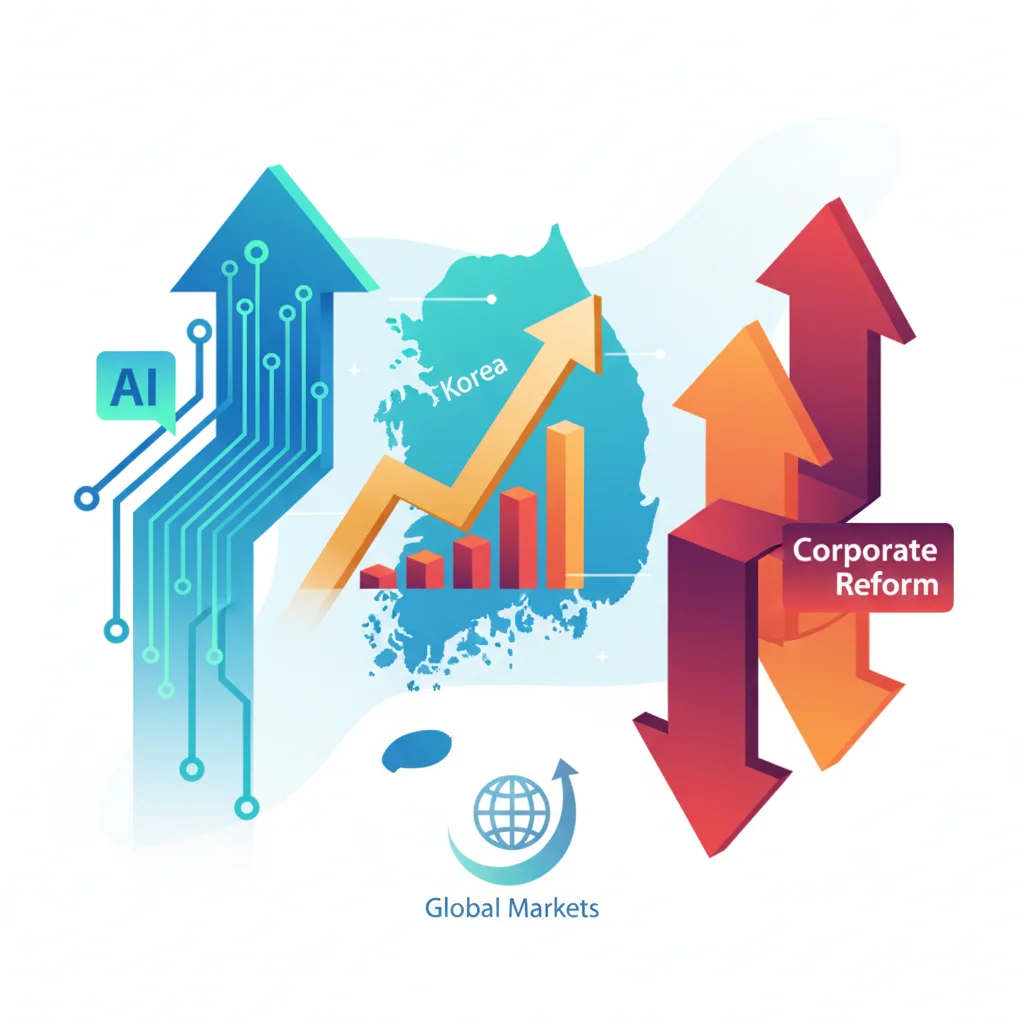
Korea’s Stock Market Surge: Unpacking the Twin Engines of AI and Corporate Reform
The Unlikely Champion of Global Markets
In the dynamic world of global finance, a surprising leader has emerged. While investors have been fixated on the tech-driven rallies in the United States, South Korea’s benchmark stock index, the Kospi, has been quietly staging a phenomenal comeback. The market has surged by an astonishing 66% this year, outpacing major indices worldwide and capturing the attention of savvy investors and finance professionals. This isn’t a random market fluctuation; it’s a powerful convergence of two seismic shifts: a global technology revolution and a domestic corporate awakening.
At the heart of this rally are the twin engines of Artificial Intelligence (AI) and a long-overdue push for corporate governance reform. On one hand, the insatiable global demand for AI hardware is supercharging South Korea’s tech titans. On the other, a government-led initiative is finally tackling the infamous “Korea Discount,” a persistent valuation gap that has plagued the nation’s stock market for decades. Together, these forces are reshaping the landscape of investing in Asia and offering a compelling case study in how technology and policy can unlock immense economic value. This post will dissect these two powerful drivers, explore their synergy, and analyze what this means for the future of the South Korean economy and global investors.
Driver 1: Riding the AI Wave on a Tsunami of Semiconductors
The global AI boom is built on a foundation of silicon, and South Korea is one of the world’s primary architects of that foundation. The nation’s economy is dominated by semiconductor giants like Samsung Electronics and SK Hynix, which are critical players in the production of high-bandwidth memory (HBM) chips. These are not your standard memory chips; HBM is a specialized, high-performance RAM essential for training and running the large language models (LLMs) that power generative AI platforms like ChatGPT.
As tech companies worldwide race to build out their AI infrastructure, the demand for these sophisticated chips has skyrocketed. This has translated into a massive windfall for South Korea’s flagship companies, whose stock prices have soared, pulling the entire Kospi index up with them. The performance of these tech behemoths is so significant that their trajectory often dictates the direction of the country’s broader stock market. This AI-fueled demand is not just a short-term boost; it represents a fundamental shift in the technology sector, placing South Korean firms at the epicenter of one of the most significant technological transformations of our time. The rally reflects a global bet that the country’s prowess in advanced manufacturing will be indispensable for the foreseeable future of financial technology and AI development.
Beyond the Slice: What Pizza Hut's UK Closures Reveal About the Shifting Economic Landscape
Driver 2: Dismantling the “Korea Discount” Brick by Brick
For decades, international investors have approached the South Korean stock market with a degree of caution, citing what is known as the “Korea Discount.” This term refers to the persistent tendency for South Korean companies to trade at lower valuations compared to their global peers, even when their underlying performance is strong. The reasons are complex and deeply rooted in the country’s corporate culture.
- Chaebol Dominance: The market is dominated by large, family-controlled conglomerates known as chaebols. Their intricate cross-shareholding structures often prioritize the founding families’ control over shareholder returns.
- Low Shareholder Returns: Historically, Korean companies have been notorious for their low dividend payout ratios and infrequent share buybacks, hoarding cash instead of returning it to investors.
- Opaque Governance: A lack of transparency and concerns about the treatment of minority shareholders have deterred many foreign institutional investors.
To address this, the South Korean government launched the “Corporate Value-up Program” in early 2024. Inspired by similar successful reforms in Japan, this initiative aims to pressure companies to improve shareholder value. It encourages them to boost dividend payouts, cancel treasury stocks, and provide clear roadmaps for improving their return on equity. The government has signaled it will offer incentives like tax benefits for compliant firms and create a new “Korea Value-up Index” to highlight leaders in corporate governance. This policy shift has sent a powerful signal to the market that the era of ignoring shareholders may be coming to an end, sparking renewed interest from both domestic and international investors who see a significant re-rating opportunity.
To visualize the valuation gap the “Corporate Value-up Program” aims to close, consider the following comparison of Price-to-Book (P/B) ratios, a key metric used by investors to assess valuation. A lower P/B ratio can suggest a company is undervalued.
| Market/Region | Average Price-to-Book (P/B) Ratio (Approx.) | Key Characteristics |
|---|---|---|
| South Korea (Kospi) | 0.9x | Historically low due to “Korea Discount,” low payouts |
| Japan (Topix) | 1.4x | Valuations improved post-governance reforms |
| United States (S&P 500) | 4.0x | Higher valuations driven by tech and shareholder-friendly policies |
| Global Average (MSCI World) | 2.8x | Represents a broad mix of developed market valuations |
Note: P/B ratios are approximate and fluctuate with market conditions. The data is illustrative of the long-standing valuation gap.
Beyond the Slice: A Financial Autopsy of Pizza Hut's UK Restructuring
The Flywheel Effect: When Tech Profits Meet Shareholder Pressure
The true power of the current rally lies in the synergy between the AI boom and governance reform. They are not two separate stories but two interconnected gears driving the market forward. The massive profits generated by the AI-driven demand for semiconductors provide the fuel, while the “Corporate Value-up Program” provides the pressure to channel that fuel toward shareholders.
In the past, a surge in profits at a major Korean tech firm might have been funneled into sprawling, unrelated diversification projects or simply added to a growing pile of cash on the balance sheet. Today, with the government and investors watching closely, there is immense pressure to use these windfall profits for shareholder-friendly actions. This creates a powerful flywheel effect:
- AI demand drives record profits for tech companies.
- Governance reforms pressure these companies to increase dividends and buy back shares.
- Higher returns and better governance attract more foreign and institutional capital.
- This influx of capital bids up stock prices further, closing the “Korea Discount.”
– This directly increases returns for shareholders.
This virtuous cycle is changing the fundamental economics of investing in South Korea. It’s a shift from betting solely on a company’s operational success to betting on a combination of operational success and a commitment to capital efficiency and shareholder returns. This dual-track narrative makes the market exceptionally compelling in the current global finance environment.
Navigating the Road Ahead: Opportunities and Risks
Despite the overwhelmingly positive momentum, the path forward is not without potential obstacles. Any serious investor or business leader looking at the South Korean stock market must consider the risks alongside the opportunities.
On the risk side, geopolitical tensions with North Korea remain a persistent, albeit often dormant, threat. The ongoing tech rivalry between the U.S. and China could also create complex supply chain challenges for South Korea’s semiconductor industry, which serves clients in both nations. On the domestic front, the biggest risk remains the potential for “reform fatigue” or a change in political will that could weaken the “Corporate Value-up Program.”
However, the opportunity is equally profound. If the governance reforms take root, they could lead to a permanent re-rating of the entire market, unlocking decades of suppressed value. The continued integration of advanced financial technology and even the potential use of blockchain for enhanced corporate transparency could further accelerate this process. For investors, this means the potential for returns comes not just from earnings growth driven by the AI revolution, but also from the closing of the historical valuation gap. The key will be to selectively invest in companies that are not only beneficiaries of the tech cycle but are also genuine leaders in the corporate governance transformation.
The Investor's Guide to Geopolitics: Why the West is Playing Go, Not Chess, with Russia
Conclusion: A Market Reborn?
The remarkable performance of the South Korean stock market in 2024 is more than just a fleeting rally; it’s a signal of a potential structural transformation. The convergence of a once-in-a-generation technology boom with a determined push for corporate reform has created a uniquely powerful catalyst for growth. The world’s best-performing stock market is being driven by a compelling story of a high-tech economy finally beginning to align its corporate practices with its technological prowess.
For investors, finance professionals, and business leaders, the question is no longer whether to pay attention to South Korea, but how to strategically engage with this evolving landscape. The journey to close the “Korea Discount” will be a marathon, not a sprint, but for the first time in a long time, the race has definitively begun. Watching how this interplay between global tech trends and local economic policy unfolds will be one of the most fascinating stories in global finance for years to come.


